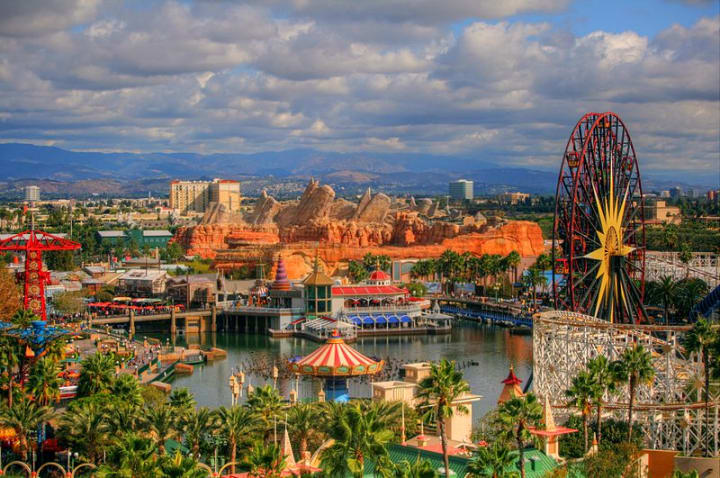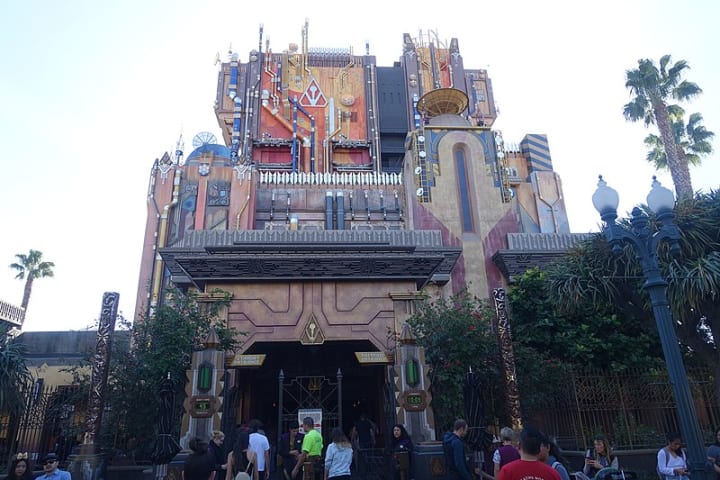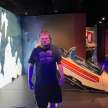Disney California Adventure
Failure, Success, and Back to Failure


Failure
Disney's California Adventure might not be the worst entertainment idea ever to come out of the Golden State—after all, someone thought it was a good idea to make a feature film about emojis, but it very well could be the worst that ever came out of the house that Walt built.
It could be the most flawed concept ever created for a theme park: "Let's build a theme park in California about California catering to a clientele consisting of Californians." Part of the concept was actually to simulate a seaside California amusement park charging Californians twice as much money as it would cost to go to an authentic seaside park.
To be fair, this critique assumes that the Anaheim Disney property can now be considered more of a local park than the groundbreaking world event it was when it opened as the first Disney park in 1955. But to be sure, Orlando, Florida, with the four parks comprising Walt Disney World, along with the waterparks and amenities that the site affords—not to mention the other companies that reinforced the city's reputation as the mecca of theme parks—has supplanted Disneyland as the world destination for all things Disney. This is in spite of the fact, that many, including myself, still consider the original Disneyland park the greatest theme park of them all.
Disney has all but conceded that Disneyland is a park that is in large part for locals. Locals get special deals, swell the park on certain days (like the day before school goes back in session), and locals represent a large portion of the Disneyland attendance.
So we go back to the early 1990s as ambitious Disney execs and imagineers plot out and create a sister park for the venerable Disneyland site. Devising a way to repurpose what had been parking areas for Disneyland, they began to plan a project they called Westcot, which was basically to be a West Coast version of EPCOT in Walt Disney World. The plans were exciting, but met a quick demise when in 1992 Disneyland Paris launched. Suffice to say, Paris was a bit of a financial disaster whose effects were felt throughout the world of pre-ABC Disney, and among the victims of the attendant cost-cutting was the Westcot project.
A few years later, around 1996, the California Adventure concept arose from the ashes of the Westcot plans. Unfortunately, by this time, then-Disney CEO Michael Eisner had put former Disney Store Executive Paul Pressler in charge of the Disney Parks. Whereas previous execs in this position had at least a strong feel for the creative side of the parks, Pressler was almost exclusively a retail man and his tenure running the Disney Parks included lots of cost-cutting, leading to a decrease in show quality and ultimately compromising ride safety. California Adventure reflected all the worst tendencies of Pressler's stewardship.
Not only was California Adventure now an unclear and flawed concept, it was deliberately built on the cheap. An entire section, called Paradise Pier, surrounded a body of water called Paradise Bay, was one of the better features of the park. However, much of the pier was given over to off-the-shelf amusements that replicated seaside parks not only in California but in almost any beach town—and in many towns nowhere near a beach.
What's more, restaurants and retail seemed to be more important to the planners than shows and attractions. Unlike neighboring Disneyland, the New Park did not have a berm to block out the outside world causing visual intrusions from the city of Anaheim, which planners say was all by design. They literally did the polar opposite of the designs that had kept the main Disneyland Park successful for over 40 years. In fact when legendary Disney Imagineer John Hench toured the new park before its opening, he reportedly said he preferred it as a parking lot.
When the original Disney's California Adventure Park opened in February 2001, it consisted of 4 major lands. The original entryway was called Sunshine Plaza, with the idea being that you entered the park through a giant California postcard. How successfully that goal was achieved is questionable.
In front of the entrance were giant letters spelling out the word "CALIFORNIA," designed to provide photo opportunities. On each side of the entrance were two of the worlds largest ceramic-tile murals, depicting famous California landmarks after entering the park, guests entered under a monorail beam dressed to look like a VERY miniature version of San Francisco's Golden Gate Bridge. After passing the bridge were two barely themed warehouse-like shops on either side and in the center was the sun sculpture and fountain. Needless to say this was not the most glamorous entryway to a Disney Park Imagineers have designed—especially when compared to the landmark Main Street U.S.A, just across the Esplanade.
Hollywood Pictures Backlot was pretty much what it sounds like, a series of restaurants and shops in buildings that are supposed to represent a Hollywood backlot. The lot including a fake skyline painted on the outside of the Hyperion theater, a concept similarly used in the backlot at what was then Disney-MGM Studios in Florida, though that backdrop was Streets of America, a much more effective depiction of the streets of New York and San Francisco.
The Backlot was also the West Coast home of Muppet Vision 3.D., a replication of an MGM Studios attraction, and probably the worst attraction ever designed for a Disney Park: "Superstar Limo." Originally conceived as a ride where you are chased by the paparazzi, the plot was changed prior to park opening because of the paparazzi-blamed death of Princess Diana in 1997. By the time California Adventure opened, the concept had devolved to a limo ride through the streets of Hollywood with some of the ugliest Animatronic caricatures of B-list celebrities you can imagine. (By now, Disney had completed acquisition of the ABC television network and the celebrities reflected its new property, including such ABC fixtures as Regis Philbin, Whoopi Goldberg, and Drew Carey). The limo ride lasted barely a year, its building and ride path were changed much later to feature a kids' ride based on the characters from the Pixar film Monsters, Inc.
The largest section of the park, Golden State, consisted of three sub-lands, Condor Flats, Grizzly Peak, and Pacific Wharf. Condor Flats was home to what was without question the original park's headline attraction (and probably still its greatest original contribution to the Disney Parks), Soarin' Over California, a tour of the Golden State via IMAX film technology and an innovative hang-glider ride system.
Grizzly Peak was home to Grizzly River Run, actually a quite intense white-water raft experience, circling a distinctive Grizzly Bear-shaped mountain peak as well as the Redwood Creek Challenge Trail. Pacific Wharf was (and remains) the only Disney Theme Park Land consisting only of restaurants.
The most controversial most un-Disney like land was the previously mentioned Paradise Pier, which featured off the shelf attractions found in any decent amusement park. The centerpiece was the California Screamin' Roller Coaster (the name being one of the many bad California puns featured in the park with only the outline of Mickey Mouse's head to drive home the Disney connection), a decent but not overly impressive standard roller coaster.
Other Paradise Pier attractions included the Sun Wheel, a ferris wheel based on New York's Wonder Wheel with swaying gondolas. The Orange Stinger was a typical swing ride inside a giant representation of an orange. The Maliboomer was a typical space-shot Drop tower model themed to a carnival High Striker.
Most ill-conceived of all, the Pier featured typical carnival games like basketball toss and such, with little additional theming and quite tacky signage. Upon opening in 2001, the park under-performed all expectations and became the butt of jokes on comedy shows, notably The Simpsons.
Disney's initial reaction to the negative publicity generated by DCA was relatively tepid at first. In 2002 A Bug's Land debuted to address the lack of rides for young children, one of the main criticisms of the initial park. In 2004 a smaller, abbreviated version of The Twilight Zone Tower of Terror from Disney-MGM Studios in Florida (Now Disney's Hollywood Studios) was added to Hollywood Pictures Backlot—a move that boosted attendance to the park moderately.
Success

It was not until 2007 that Disney finally acknowledged the extent of its failure with Disney's California Adventure and announced a $1.2 billion makeover plan to bring the park up up to traditional Disney standards. The first area to receive attention was Paradise Pier—first with the 2008 opening of Toy Story Midway Mania!, a ride-through a series of midway carnival games hosted by characters from the Toy Story Franchise. In phases from 2009 until 2011 the tacky original look and themes from the original Paradise Pier were changed to reflect an early 20th Century look, and the boardwalk games were re-themed to Disney and Pixar Characters. A decent improvement but not yet a fix.
The Sun (Ferris) Wheel had its sun face replaced by the smiling face of Mickey Mouse and was renamed Mickey's Fun Wheel. To accommodate this, the outline of Mickey Mouse's head on California Screamin' was replaced with a Paradise Pier sign and sunburst. Other than a narrator change, the ride was unchanged. And the essential problems of the rides and the original pier concept were still not addressed: the best Disney rides give immersive experiences. With no back story, valid or forced, the rides were just a ferris wheel and above-average roller coaster, both of which could be experienced at any typical amusement park, at lower cost and, for most people, with far less travel time.
Other major changes followed: the Maliboomer was removed completely; The Orange Stinger became Silly Symphony Swings; Mulholland Madness became Goofy's Sky School. In the summer of 2010, a water projection show named World of Color debuted in Paradise Bay and the park was renamed Disney California Adventure. While it was no Fantasmic or Reflections of Earth, or even an equal to the Disneyland fireworks, it was a successful show, as it played into Disney's strengths of water projections and pyrotechnic effects.
In 2011, The Little Mermaid, Ariel's Undersea Adventure opened on the former site of the film Golden Dreams. If you spent any of your Disneyland trip in Fantasyland, the area just behind the castle that features "dark rides" about Peter Pan, Snow White, Pinocchio, and more, what you'll notice is the immense amount of space dedicated to the Mermaid Ride. What you won't notice is anything happening in the ride that is any better than or even as good as what happens in the more space-conscious Fantasyland rides. A very literal reading of the movie, it has plenty of spectacle but not a whole lot of ride experience.
In 2011 Sunshine Plaza closed, to be transformed into Buena Vista Street, a 1920s streetscape at the entrance, with the Monorail beam re-themed to the Glendale-Hyperion Bridge The CALIFORNIA letters and Ceramic Murals were removed, a new entrance resembling the Pan-Pacific Auditorium was built and the Sun sculpture and fountain were removed and a replica of a lost Hollywood landmark, The Carthay Circle Theater, was built in its place. The Red Car Trolley connected Buena Vista Street to the newly re-named Hollywood Land and the Tower of Terror, sadly not much else was improved in the land.
The most ambitious change came in 2012, with the introduction of Cars Land, a re-creation of the town of Radiator Springs from the 2006 Disney. Pixar film Cars. This was an entirely new land added as part of the expansion that featured three new rides. Mater's Junkyard Jamboree is a mild whip-style ride with a soundtrack featuring the rare sound of Larry the Cable Guy Serenading you with song while you ride, which is okay for a while and maybe longer for the small fry. Be fairly warned however to linger in that neighborhood at your own risk.
The second ride was Luigi's Flying Tires, a 21st Century Version of Disneyland's Flying Saucers that sadly would end up suffering similar mechanical problems as its creative ancestor and was closed after only three years of operation.
The ride that could bring a grown Disneyphile to tears, however, was the Headline Attraction: Radiator Springs Racers, a classic dark-ride and thrill-ride combination that became the latest E-Ticket Attraction in Disney's lineup. It's an effective ride for child and adult alike, at times feeling a bit like a ride on Test Track at EPCOT, but with exciting visuals and a lot of Pixar magic for the young riders.
When Cars Land and Buena Vista Street opened in June 2012, the park was re-dedicated by Disney CEO Bob Iger. At last, the park was beginning to live up to its potential and develop a new identity, where in the initial incarnation its identity barely registered at all.
Things continued to improve in 2015 when the original Condor Flats was re-themed and merged into the theming of nearby Grizzly Peak. Soarin' Over California shined in a new digital transfer that made the sensation of flight even more believable. At that point, Disney California Adventure was as close to being in ideal shape as the park has ever been.
Back To Failure

In 2016, however, things started to change that could ultimately destroy much of the hard work Imagineering had done to improve the park. First the beloved Aladdin show in the Hyperion Theater was replaced with yet another show featuring Disney's most recent hot franchise Frozen. While I understand the desire to get Frozen while it's hot, one of the main things about Disney theme parks is that that they stress the wide world of Disney—the many films and interest that make up the panoply of their entertainment holdings.
Other changes included the opening of Luigi's Rollicking Roadsters in Cars Land and the replacement of Soarin Over California with Soarin' Around the World. Soarin' Around the World was clearly designed to fit into the Soarin' attractions at Shanghai and Florida's EPCOT and to me is out of place with the park's California theme. Seemingly, this was just shoehorned in so Disney could market a "new" attraction.
In my opinion, however, an even more damaging development was on the horizon. Early in 2016, internet rumors had the beloved Tower of Terror being replaced with a Guardians of the Galaxy themed ride. At first this sounded absurd. After all, a lot of the placemaking and design of the new Buena Vista Street and Hollywood Land were specifically designed to match the Tower of Terror's aesthetic, that of a specifically designed story built around the old but still beloved Twilight Zone television series. How would a futuristic looking building featuring science fiction characters fit in the theme of 1930s Hollywood suggested by the Hollywood land area?
Still, in July 2016, Guardians of the Galaxy: Mission Breakout was announced. Tower of Terror closed in January 2017 and the introduction of the Guardians ride came on Memorial Day weekend. Mission Cashgrab (as I refer to it) sticks out like a sore thumb when seen juxtaposed with the existing lands especially on Buena Vista Street and Hollywood Land. It's a textbook example of how a ride mechanism can feel completely different and alter the whole experience based on how it is themed. Where Tower of Terror was a classic, the new attraction is irreverent, cheap, ugly, and painfully self-referential—essentially something that would have been at home in the original Disney's California Adventure.
In one swoop Disney had destroyed the coherence of DCA for which they had spent $1.2 Billion dollars. To make matters worse, they turned Paradise Pier into Pixar Pier in early 2018; California Screamin' was transformed into the IncrediCoaster based on the Pixar Incredibles franchise with a very unfunny pre-boarding video talking about "synergy" continuing the self-referential streak begun in Mission Cashgrab. The roller-coaster now has a tacked on story about the family trying to rescue Baby Jack-Jack. the Maliboomer pad was filled with Inside Out Emotional Whirlwind. The themed snack carts on the pier are very tacky looking.
What's more, they didn't even bother to re-theme the whole area to Pixar, with the Mickey Mouse's face remaining on the ferris wheel now called the Pixar Pal-A-Round. The area with the Silly Symphony Swings, Golden Zephyr ,Goofy's Sky School, Jumpin Jellyfish and The Little Mermaid was re-dubbed Paradise Gardens Park in a cheap attempt to not re-theme the area. The concept feels cheap and contrived to me. In 2021 the area that had been A Bugs Land became the Marvel-themed Avengers Campus showing that Disney could care less about a unifying vintage California theme that seemed so promising back in 2012. At the 2022 D23 Expo it was announced that Pacific Wharf would become San Fransokyo from the film Big Hero 6 continuing to prove that Disney could care less about overarching themes for their parks and just sees them as glorified advertising billboards. San Fransokyo opened in September of 2023. It is sad that the effective adjustments Imagineering had made to make the park cohesive seem to have been undermined so soon.
About the Creator
Sean Callaghan
Neurodivergent, Writer, Drummer, Singer, Percussionist, Star Wars and Disney Devotee.






Comments
There are no comments for this story
Be the first to respond and start the conversation.